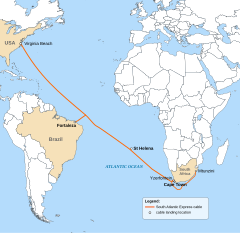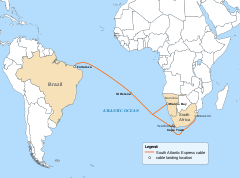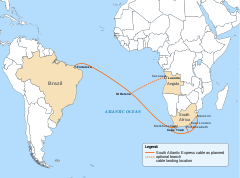Telecommunications in Tanzania include radio, television, fixed and mobile telephones, and the Internet available in mainland Tanzania and the semiautonomous Zanzibar archipelago.
A transatlantic telecommunications cable is a submarine communications cable connecting one side of the Atlantic Ocean to the other. In the 19th and early 20th centuries, each cable was a single wire. After mid-century, coaxial cable came into use, with amplifiers. Late in the 20th century, all cables installed used optical fiber as well as optical amplifiers, because distances range thousands of kilometers.
SAT-3/WASC or South Atlantic 3/West Africa Submarine Cable is a submarine communications cable linking Portugal and Spain to South Africa, with connections to several West African countries along the route. It forms part of the SAT-3/WASC/SAFE cable system, where the SAFE cable links South Africa to Asia. The SAT-3/WASC/SAFE system provides a path between Asia and Europe for telecommunications traffic that is an alternative to the cable routes that pass through the Middle East, such as SEA-ME-WE 3 and FLAG. SAT-3 has a capacity of 340 Gbit/s while SAFE has a capacity of 440 Gbit/s. The SAT-3 system together with SAFE was built by a consortium of operators. As of 2006, major investors included Telkom Group, France Telecom (12.08%), Nitel (8.39%); TCI, a subsidiary of AT&T Inc. (12.42%); and VSNL (8.93%).
The Eastern Africa Submarine Cable System (EASSy) is an undersea fibre optic cable system connecting countries in Eastern Africa to the rest of the world.
Mtunzini is a small coastal town that is situated almost exactly halfway along KwaZulu-Natal's coastline in South Africa approximately 140 km north of Durban. In 2011, the town's population was 2,199.

The Internet in South Africa, one of the most technologically resourced countries on the African continent, is expanding. The internet country code top-level domain (ccTLD) .za is managed and regulated by the .za Domain Name Authority (.ZADNA) and was granted to South Africa by the Internet Corporation for Assigned Names and Numbers (ICANN) in 1990. Over 60% of Internet traffic generated on the African continent originates from South Africa. As of 2020, 41.5 million people were Internet users.

SEACOM launched Africa's first broadband submarine cable system along the continent's Eastern and Southern coasts in 2009. SEACOM is privately owned and operated.
Telecommunications in Angola include telephone, radio, television, and the Internet. The government controls all broadcast media with a nationwide reach.
The Main One Cable is a submarine communications cable stretching from Portugal to South Africa with landings along the route in various west African countries. On April 28, 2008, it was announced that Main Street Technologies has awarded a turnkey supply contract for the Main One Cable System to Tyco Telecommunications.

The West Africa Cable System (WACS) is a submarine communications cable linking South Africa with the United Kingdom along the west coast of Africa that was constructed by Alcatel-Lucent. The cable consists of four fibre pairs and is 14,530 km in length, linking from Yzerfontein in the Western Cape of South Africa to London in the United Kingdom. It has 14 landing points, 12 along the western coast of Africa and 2 in Europe completed on land by a cable termination station in London. The total cost for the cable system is $650 million. WACS was originally known as the Africa West Coast Cable (AWCC) and was planned to branch to South America but this was dropped and the system eventually became the West African Cable System.
Saint Helena, Ascension and Tristan da Cunha is a British Overseas Territory in the South Atlantic, consisting of the island of Saint Helena, Ascension Island and the archipelago of Tristan da Cunha including Gough Island. Their communications provision includes dedicated radio and television stations, and telecommunications infrastructure.
A Human Right is a non-profit organization dedicated to providing free basic internet and phone access to developing countries, and to citizens of countries whose government has cut off or restricted internet access. It was discontinued in 2016.
Angola Cables is an Angolan multinational telecommunications operator of fiber-optic telecommunication cables.
The South Atlantic Cable System or SACS, is a submarine communications cable in the South Atlantic Ocean linking Luanda, Angola with Fortaleza, Brazil with a leg connecting the Brazilian archipelago of Fernando de Noronha as well. It is the first low latency routing between Africa and South America.

WASACE was a planned system of submarine communications cables consisting of four sections with a total length of 29,000 km linking four continents.

Seaborn Networks is a developer, owner, and operator of submarine communications cables. Seaborn is the owner and operator of the Seabras-1 "submarine communications cable" between Brazil and the United States. Seabras-1 is fully operational (2017) and provides the first direct route between Sao Paulo, Brazil, and the United States. The system has branching units installed on certain of its fiber pairs that point towards Virginia Beach (US), Miami (US), St. Croix (US), Fortaleza (Brazil), Cape Town, Rio de Janeiro (Brazil), Brazil South. Seaborn's ARBR subsea system is a fully funded 4-fiber pair, 48Tbit/s system. ARBR will directly connect São Paulo, Brazil to Buenos Aires, Argentina. ARBR will connect to Seabras-1 in Seaborn's Praia Grande CLS enabling the most direct, lower latency connection between Argentina and the USA. Partners Group is providing full project equity capital for Seabras-1 and development capital was provided by Seaborn. Seabras-1 is owned jointly by Seaborn Networks and Partners Group. The US$520 million project funding for Seabras-1 has been completed. The project funding also includes a total project debt commitment of up to US$267 million provided by Natixis, Banco Santander, Commerzbank, and Intesa Sanpaolo, which debt is backed by COFACE, the French Export Credit Agency. Seabras-1 is the first direct point-to-point submarine cable system between the financial centers of the US and Brazil.

The South Atlantic Inter Link (SAIL) is a submarine communications cable in the South Atlantic Ocean linking Kribi, Cameroon with Fortaleza, Brazil.
The BRICS Cable is a planned optical fibre submarine communications cable system that carries telecommunications between the BRICS countries, specifically Brazil, Russia, India, China and South Africa. The cable was announced in 2012 but was still under construction as of 2015. The project aims to provide bandwidth around the Southern Hemisphere of the globe, and to "ensure that developing nations’ communications are not all in the hands of the nations of the North".











